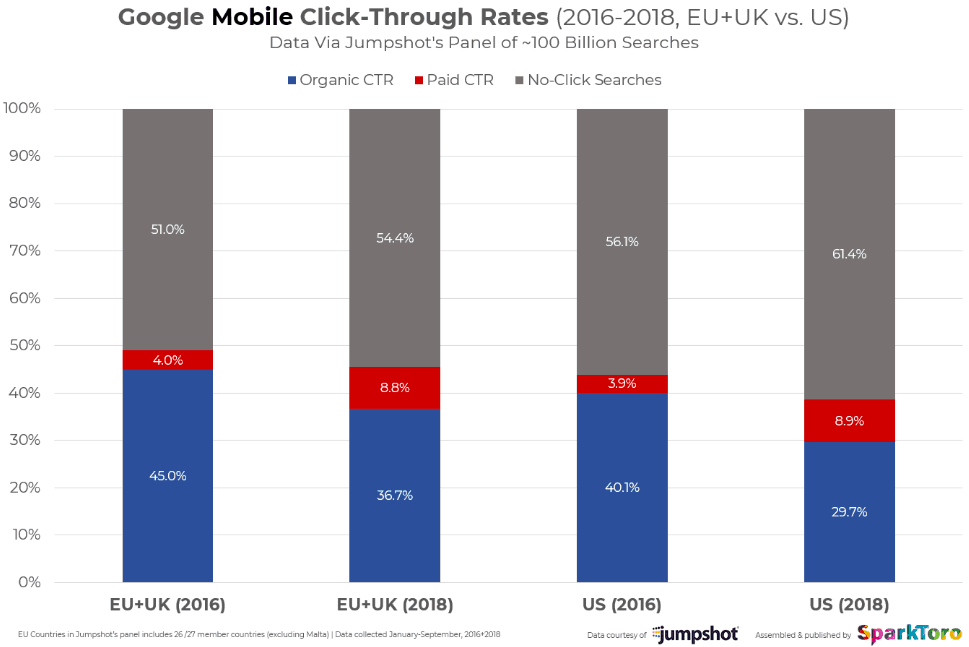Changes in Google SERPs Make Organic Traffic Difficult
Are you worried because your organic search click-through rates (CTRs) have been dropping lately?
You’re not alone.
If this is happening to you, it’s important for you to understand that organic search CTRs are dropping all around the world due to changes in Google’s search engine results pages (SERPs).
The good news is that your CTR drop doesn’t necessarily mean there’s something wrong with your SEO strategy (although the possibility is there). It’s very likely that your decrease in CTR is happening because your business, like thousands of others, is being affected by multiple Google algorithm updates, which have continued to roll out over the past 13 months or so, through Q1 of 2019.
Why?
In simple terms:
Due to changes in the SERPs, it has become increasingly difficult to drive organic traffic from search engines, especially on mobile. And even though there are tactics to combat this, some loss in traffic or CTR might be inevitable.
In this post, we’re going to explain why this is a Google-wide thing, and how websites all around the world are being affected by this trend. And no, your business isn’t doomed. Even if your website has seen a drop in traffic over the last couple of years, there are certainly things to do about this. We’ll be keeping you updated on the latest industry changes so you’re not left scratching your head, wondering what’s happening.
If you’re ready for our help, don’t hesitate to contact us.
The decline of organic search CTRs
New data and analysis from SparkToro reveals the drop in CTR that Google Desktop has been experiencing over the last couple of years. As you can see in the graph, paid CTR and no-click searches have increased at the expense of organic CTR.

In Europe, organic click-through rates on desktop dropped from 66.9 percent to 63.6 percent (a decrease of 3.3 percent), and in the U.S. from 62.7 percent to 60.4 percent (a reduction of 2.3 percent).
A decrease of 3 percent is notable, but you’re probably thinking that it’s not enough to significantly impact your business.
But that’s because you haven’t seen the other graph.
Let’s take a look at what’s happening on mobile:

If you analyze the graph, you’ll quickly realize that it’s on mobile where things are getting really ugly.
In 2016, organic click-through rates were beautifully high, above the 40 percent mark both in the U.S. and Europe (45 percent in Europe vs. 40.1 percent in the U.S.).
In the last couple of years, they’ve dropped by a whopping 10 percent in both regions.
The clicks you can get from Google have diminished, especially on mobile.
It’s still beneficial to rank in the SERPs, but more effort is required to achieve the same results you would have achieved a couple of years ago when it was easier to get organic traffic from mobile.
So, why is this happening? Why have paid CTRs and no-click searches increased while organic search CTRs have decreased?
The answer lies in Google’s prioritization of ads and answers.

In the image above, you can see an excellent example of how Google’s own answers drive traffic away from other websites. Since users find what they need in the answer boxes, they are less likely to click on other sites.
Here’s another example:

In this example, sponsored ads appear on top of the page, driving traffic away from organic search listings.
It’s not clear exactly what’s causing the increase in paid CTRs, but it’s probably due to either more ads/answers per query, ads/answers on more queries, larger ads/answers or all of the above.
The reason why the drop is more significant on mobile is that the screens are much smaller, and since ads are at the top, it often takes a few swipes to reach the organic links.
Desktop screens are much bigger, and you can see the list of websites immediately after searching, despite the ads at the top.
What does this all mean?
Google has monopolized the search engine market, and that allows them to drive more traffic to areas they monetize.
Pay-per-click (PPC) is now stronger than ever, and organic listings are getting weaker. Basically, Google is sacrificing the results of others to increase their own revenue by prioritizing ads. This trend might continue, and if it does, organic listings will see diminishing returns in the years to follow. If we’re lucky, the drop will stop, and organic CTRs will stabilize soon.
Whatever the case may be, it’s still important to have a solid SEO strategy in place. Your SERP rankings are still a priority to drive traffic and grow your business; however, now might be a good time to amp up your PPC/paid search marketing to get your website featured in these monetized-by-Google sections of the SERPs. This may be the most direct way to combat the decline in organic clicks.
Even if all of these changes seem scary, there are some other things you can do to recover, like implementing accelerated mobile pages (AMP), optimizing for voice search, etc.
Also, this is affecting everyone equally in ecommerce, and the amount of people using Google has increased, so it’s not as bad as it might sound.
So worry not!
There is a way around this, and we’re here to make sure you have everything you need to overcome Google’s ever-changing waters.
Did your site take a hit from the new SERP features? We’re here to help. Call us at (844) 304-3088 or email us at hello@digitalcurrent.com.


